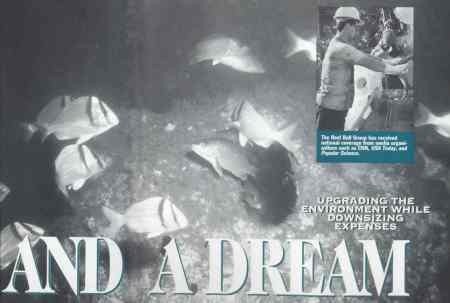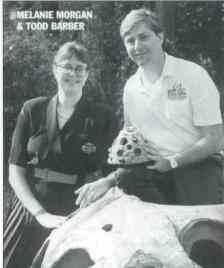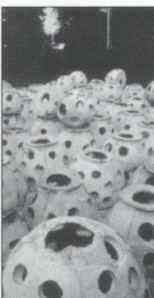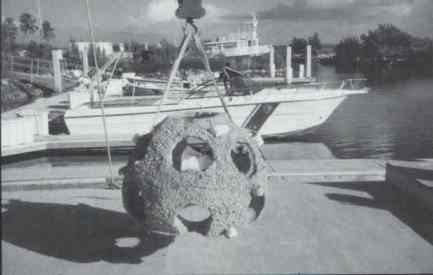

(Winter 1995)


B Y K R I S T I W O L F G A N G
How
many people would leave six-figure jobs, downsize their homes, and use almost all their
savings in an attempt to make the world a better place? Luckily for our oceans' reef
systems, Todd Barber ( BBA '85, MA '87) is just that type of person. A long-term love for
scuba diving and a serious interest in environmental mental issues made him aware of the
need to protect our remaining natural reefs.
"My interest in reefs began when I learned to scuba dive at age 14
. l was in the Cayman Islands and my father rented an underwater camera for me. I took
pictures of one particular little reef and had always intended to return, as an adult, and
see how it had grown," recalls Barber. Three years ago, he returned to fulfill his
childhood wish, but instead discovered that Hurricane Gilbert had destroyed his favorite
reef. "I immediately decided that I would somehow rebuild this reef so that my child
could learn how to scuba dive in the same place I did," he says.
That night, over a few cocktails, Barber and his father brainstormed
possible solutions to decrease a natural reef system's destruction rate. "We came up
with this crazy idea of constructing a buoyant and inexpensive artificial reef by pouring
concrete over a beach ball. Because of the inflated center, we thought we could float it
into the ocean by boat, and save the tremendous expense involved with renting a crane and
a barge to transport the object. Sinking the hall would be easy: just deflate the beach
ball center," he explains.
From that evening came the birth of a new company, Reef Ball
Development Group, Ltd. Barber knew exactly where to go for additional man/woman and brain
power: his college scuba diving pals. These environmentally aware UGA alumni (including
Barber's wife) total 24 of the 27-person organization and hold career paths such as
computer hackers, health physicists, engineers, school teachers, real estate specialists,
and artists.

"Our mission statement charters the group to restore the world's ocean
reefs through the development of new ideas, techniques, and devices designed to create
aesthetically pleasing, ecologically sound artificial reefs." Todd Barber
DIVING IN HEADFIRST
"The minute the idea germinated, we were all in contact. In the
beginning, a few people would get together according to interests and talents. Some would
construct models while others would research concrete and concrete technology," adds
Melanie Morgan (BBA '86), Reef Ball director of marketing. While attending a Dive
Equipment and Marketing Association (DEMA) trade show, Morgan analyzed the fledgling
company's potential book of sales, which was $4-5 million from one convention. "After
seeing her results, we decided that it was time to consider Reef Ball as a serious
venture," notes Barber.
Although aware that leaving his comfortable consulting position at
Towers Perrin might close the door forever in that field, Barber took the plunge. Last
year, he and his wife, Laura sold their house and used their savings and any other assets
he could find to start the business. Barber, Morgan, and four other UGA graduates went to
work full-time for Reef Ball Development Group, Ltd. The remainder of the
group worked part-time, while maintaining full-time positions in other areas.
Barber and Morgan spent all of their time developing the company and
making contacts. "Since college, Todd and I have been studying corporate structures
and the different ways businesses are run. I think that really helped us develop Reef Ball
according to our goals and the company atmosphere that we wanted," says Morgan. Both
Barber and Morgan credit the value of their UGA degrees. "Even single thing that I
learned at the business school I have applied to this company.I1 continually draw upon
things from both my undergraduate and graduate courses," remarks Barber.

A LITTLE HELP FROM FRIENDS
Making contacts and getting outside help was easier than Barber and
Morgan imagined. Barber adds, "Over the past year, we pooled as many internal
resources as we could and then for the rest, we approached outside companies and
organizations and said, 'This is what we are doing. We are helping the world. Can you help
us?' " The positive response was overwhelming.
Outside expertise from the academic community, including professors
from around the nation and Europe, provided necessary research. The University of Georgia
ecology department helped the Reef Ball group research surface technology. Reef specialist
Dr. James Porter and a team of graduate students helped the group to determine the
appropriate surface texture for attracting hard corals.
Corporate America provided the practical research collaboration
necessary to develop a concrete mixture that was virtually unknown to the entire
underwater ocean-building community. "W.R. Grace & Company,a prestigious concrete
admix company, helped us with our concrete formulation. The result was an incredibly
strong mix using natural elements, expected to have a 500-year underwater life span,"
explains Morgan.
After much research, the group came up with an effective module, with
varying openings and textured surfaces. The final dome-shaped form is made by pouring
concrete between a fiberglass mold and an inflatable bladder. Once at its deployment site,
the ball slowly sinks as its bladder is deflated.
Unlike most private companies, profit is Reef Ball's secondary goal.
"Our number one goal has always been and will always be to enhance our ocean
system," Barber remarks. "Even though it would have have been financially
beneficial to have a proprietary hold on our concrete formulation, we have shared this
technology with the reef community. Hopefully, increasing others' knowledge will expedite
ocean enhancement, " adds Morgan.
ENGINEERING ENVIRONMENTS NOT JUST ATTRACTING FISH
Protecting the natural reef system, better fishing, and developing dive
sites are all reasons to place artificial reefs. The group customizes the concrete mix and
surface structure to meet the objective and application of each particular ball. "We
have different size molds and compositions. Different surface structures attract different
ocean species. For example, in south Florida the reef ball goal is to grow coral. We mix
limestone with concrete so that hard coral will grow on the balls. In Georgia and South
Carolina, we mix granite with concrete which results in soft coral growth. Soft coral is
beneficial for the fishing industry and scuba diving because it improves the animal
habitats and attracts more fish," notes Barber.
Unfortunately, Reef Ball Foundation, Inc., cannot place reef
balls at free will. Permitting procedures vary in foreign countries and the government
controls all artificial reef permits in the United States. Luckily for Barber and crew,
all coastal states have granted them permission to place artificial reefs. Although state
environmental protection funds provide some support, the Reef Ball group felt others
needed to get involved. "Anyone can help. Diving and fishing organizations have
worked with the government to place reefs. One will provide the funds and the other
volunteers. Individual donations have built and placed reefs. Currently we are looking for
corporate sponorships to build company reefs," Barber explains.
To date Reef Ball has placed over 1,000 units from Mexico to New York
City. Reef sites include the Florida Keys, Fort Lauderdale, West Palm Beach, Charleston,
Hilton Head, Virginia, and England.
REEFS FOR THE FUTURE
The Reef Ball group is predicting a 300 percent growth rate
over the next five years. The hope to change the way artificial reefs are built on the
planet. "Within three years, we hope to deploy 10,000 reef balls. I really think it
is a matter of time before even one will want to get involved," states Barber.
The word is traveling. The group has enjoyed national coverage from
media organizations such as CNN, USA Today and Popular Science. Local
coverage a includes over 50 different television news casts and print articles. The
entertainment industry has shown an interest as well. Disney's Epcot Center wants to place
several reef balls with marine life on its Living Seas exhibit and has volunteered its
dive teams to assist with our Florida reef building projects," claims Barber.
Although pleased with all the national attention, the group maintains
that perpetuating its legacy is what is most important. Barber concludes, "I want our
children try know what we have known, and what made an everlasting impression on me as a
boy in the Cayman islands ... the remarkable beauty of the reefs."

BENEFITS OF REEF BALLS VERSUS OTHER
ARTIFICIAL REEFS
UNIQUENESS: Balls vary in composition, thickness, size, and height so that each module is different for varying goals and applications - just like natural reefs.
NON-POLLUTANT MIX: The special concrete mixes do not release anything into the water and have the same pH as sea water.
SURFACE TEXTURES: Varying surface patterns enhance marine life settlement.
EXTREMELY STABLE: Ninety percent of the ball's weight is within one foot of the bottom outside edge. This results in a greater ability to withstand movement and destruction during storms.
COST EFFECTIVE AND CONVENIENT DEPLOYMENT SYSTEM: Almost any water vehicle can tow a reef ball to its deployment site. Other artificial reefs require complicated and costly cranes and barges.